In her book, ‘The Sirius Connection’, Murry Hope writes about the colour of eyes as found in early Egyptian statues. She cites the author and Egyptologist, John Anthony West for bringing this to her attention when he commented that there are early examples of Egyptian statues in which the inlaid eyes are either blue or grey in colour. Hope writes that she reckons to have noticed how depictions of deities such as Horus showed them with eyes that had a blue pupil (without stating where those depictions can be seen though for shared observation.)
With an interest in quartz in the context of ancient history, this point in the book acted as a catalyst that lead me to find out some interesting facts to be acknowledged about these stone eyes. It isn’t surprising that they were made of rock crystal. A range of materials are known to have been used depending on the desired effect and perhaps the situation, location and purpose for which the eye, and its artifact, were created to represent. Those eyes in the possession of the Fitzwilliam Museum, for example, include the use of materials such as limestone, quartz, rock crystal, obsidian, bone and ivory, copper alloys, resin, plaster, animal glue and pigments.
What is surprising is the recognition of what exquisite craft skill and technology are implied by the use of such crystal for the eyes of these statues. To further the description of this skill, I came upon the website of Ernest Moyer, ‘Egyptian Origins’ which contains an article on the two companion statues of Rahotep and Nofret.
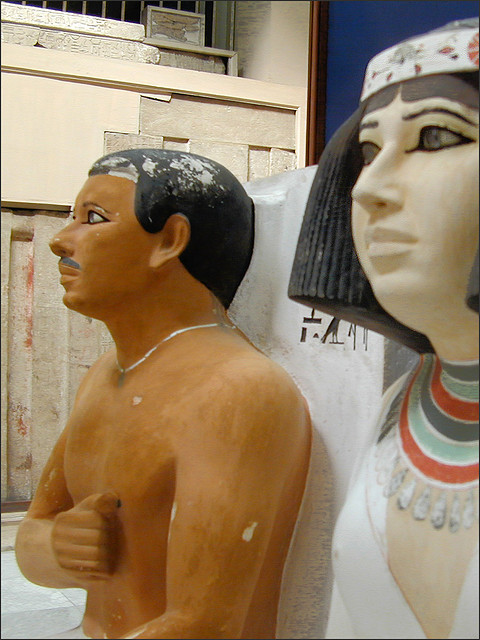 These are two famous painted limestone figures now on display in the Cairo Museum. The statues were found buried in a mastaba located near the pyramid of Meidum. It is therefore thought that they were members of a royal family of the fourth dynasty and because Sneferu was the pyramids builder, it is considered possible, though not proven, that they may have been his children. The rock crystal used for the eyes was a blue-violate color.
These are two famous painted limestone figures now on display in the Cairo Museum. The statues were found buried in a mastaba located near the pyramid of Meidum. It is therefore thought that they were members of a royal family of the fourth dynasty and because Sneferu was the pyramids builder, it is considered possible, though not proven, that they may have been his children. The rock crystal used for the eyes was a blue-violate color.
Photo credit: dalbera / iW / CC BY
Moyer’s site contains a summary of a lecture by Jay Enoch from the School of Optometry at the University of California at Berkeleythat which provides a technical description of the manufacture of the eyes. This lecture was based on research Dr. Enoch undertook at the Louvre on the famous seated scribe statue (E-3023) and a “reserve eye” from Saqqara (E-3009) from their collections along with other observations made on pieces found at the Louvre and the Egyptian Museum in Cairo. The lecture was presented to the American Research Center in Egypt, from Northern California and is fittingly quoted hereon:
“These early lenses appear fully formed about 2600-2575 BC at Meidum in the famous statues of Rahotep and his wife Nofret and reappear sporadically in small statuary throughout the Fourth and Fifth Dynasties. The peak of development of these lenses was reached circa 2475 BC. The last Old Kingdom example being that of Mitri. 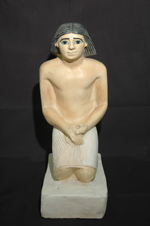 Another Fifth Dynasty statue, that of the funerary Priest Kaemked, had eye structures where the rock crystal lenses were replaced with obsidian, a dark volcanic glass. In the Sixth Dynasty, there are no known examples of these eye structures.
Another Fifth Dynasty statue, that of the funerary Priest Kaemked, had eye structures where the rock crystal lenses were replaced with obsidian, a dark volcanic glass. In the Sixth Dynasty, there are no known examples of these eye structures. 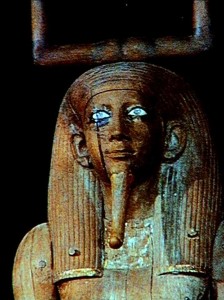 These elegant lenses/eyes then reappeared in a single example in the First Intermediate period, the statue of King Hor found at Saqqara, circa 1750 BC.
These elegant lenses/eyes then reappeared in a single example in the First Intermediate period, the statue of King Hor found at Saqqara, circa 1750 BC.
The composition of these eyes is a lens of polished rock crystal (either alpha silica or fused silica, formerly known as crystalline quartz and fused quartz which had a convex front surface and a near hemispherical concave ground pupil surface in a flat iris plane (normally covered with resin) at the rear of the lens. The white of the eye (the sclera) was carved/ground in white limestone, cloudy or translucent quartz, or marble, some of the latter contained impurities which simulate the conjunctive capillaries of the eye. These are set into the statue in copper (early forms) or bronze (late form) structures which simulate painted eyelids. They are said to sweep back to form a retina-like surface. Resins sometimes partially or fully obscure the pupillary aperture. This type of eye structure is known as a form of “schematic eye”. The structures of these eyes indicate at a minimum a very advanced understanding of the anatomy of the eye for that time. With the exception of the statue of Mitri (Fifth Dynasty), the eyes are well suited to the facial structures of the statues and Mitri’s eyes may represent a medical condition with which he was afflicted or a stylistic change.
The early examples of Nofret and Rahotep have well developed pupillary structures with thick lenses and a point as part of the pupillary concave ground rear lens, as did the reserve eye E-3009. The statue of King Hor has a ring in that ground surface instead of a point and the lens seems not as clear. Dr. Enoch noted that Late Period lenses found by Flinders Petrie at Tanis are simply not in the same class as these much earlier examples. The grinding and polishing of these eye lenses appear to be done in pairs, perhaps from the same larger crystal, and while not exactly the same, each eye is fairly close to the other in execution and their “eye following” ability.
Dr. Enoch noted that the quality of these eyes clearly indicates that these could not have been “first attempts” and must represent a development from earlier models which are lost or await discovery. Where did the technologies for these eyes develop and why were they permanently abandoned are important questions which also need further study. Certainly the Egyptians had learned to work hard stones early in their civilization (Dr. Enoch noted there are only limited examples of quartz beads, a quartz “whiskey-like shot glass” and a carved quartz lion in the predynastic collections in Cairo) – thus there are few examples of work done on early rock crystal pieces in current Egyptian collections. Could the lens technology have been imported from elsewhere and adapted to Egyptian stone working techniques or were the eye structures themselves imports? These are questions which need to be addressed. Egyptian trade routes extended far beyond its borders in the Old Kingdom and early dynastic period.
The schematic eye may be best studied with a “reserve eye” found in the Louvre (E-3009) since it is not blocked with any resins, the top is open for viewing, looking at the image plane and is not in place in any statue. Where did the materials come from to create this schematic eye and how were they worked? Indications from the snugness of the fit in these eyes suggest they may have been turned on a lathe. Egyptian stone working techniques (shown in a jewelry making scene from the tomb of Mereruka at Saqqara) demonstrate the use of the bow drill for cutting stone, probably with an abrasive such as corundum (found in the Levant in the Cyclades Islands and Anatolia and also from the Indus Valley) or emery sands from Egypt’s own eastern desert. Dr. Enoch pointed out that low speed drilling with an abrasive can easily account for the lenses seen in these statues, perhaps using papyrus stem drills and a slurry of water and emery or “good old-fashioned spit”.
A number of optical and opthalmic tests were performed on the reserve eye and the scribe Accroupi, a number of which worked while others did not. A keratometer (a device normally used for examining the cornea of a real eye) was used to measure the convex lens mirror surface of the lenses, which were shown to have astigmatic errors. It is interesting to note that virtually all ancient lenses demonstrate astigmatism (a structural defect in a lens or eye that prevents light rays from an object from meeting in a single focal point, so the object appears indistinctly formed). The construction of the reserve eye lens results in certain findings which are very close to real human eyes. The image of the pupil of a real eye lies at circa 3.6 mm from the front surface while the image of the pupil of the schematic reserve eye lies at circa 4.6/4.7 mm. Direct measurement of the reserve eye diameter was 14.33 mm, while photographic records of the schematic eye measured 14.2 mm – a remarkable concurrence of measurements, all things considered. The pupil image was circa 1/4 of the diameter of the front lens of the schematic eye. The illusion of the following eye results from a form of image parallax, that is, the main factor is the appearance of the location of the pupil image perceived as you move around the eye structure.
Dr. Enoch’s team was unable to measure the birefringence (double refracting property) of these rock crystal lens elements. The technique used was not meant for so thick a lens element. The thickness of these lenses proved a surprise! These lens/eye structures were clearly designed to enhance the eye following illusion, and were not meant to wholly mimic real eye structures. These creations utilize defined convex and concave surfaces. Of the pieces examined by Dr. Enoch, the seated scribe from the Louvre has the finest “eye following” ability.
This line of inquiry opens up as many areas of study as it answers. Dr. Enoch reiterated his amazement at the technological achievements these schematic eyes represent, particularly at such an early period in human culture. He knows of no other lenses with these unique “eye following” abilities, past or present. That these lenses were so unique, so well constructed and polished, and so complex suggests that these oldest lenses were not the first lenses.”
This lecture, by someone who knows what he is talking about, clarifies the technology required and raises appraise for the ancient Egyptians’ skill. The making of these crystal eyes is an amazing achievement. It clearly demonstrates an advanced skill and a creative mind.Dr Enoch, whose work informs the lecture, is clear that these could not have been the first attempts at developing the technique which involved consider knowledge and skill to grind the lenses involving perhaps a bow drill, papyrus stem drills, corundum or emery sands as an abrasive for grinding and polishing. Perhaps the stone work and materials were imported, as the article suggests from either the Cyclades Islands, Anatolia or Indus Valley? In any case the feat is remarkable given the widely known history for the period which seems to obscure generally such achievement.
The page on Ernest Moyer’s website can be found here http://www.egyptorigins.org/rahotepandnofret.htm
There is more to this yet than meets the eye.
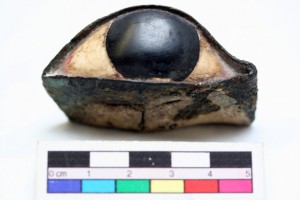 Here is a post found on a blog of the Fitzwilliam Museum Conservation Students and posted on April 15 2013. It is written by Alexandra Zappa who was a former objects conservation intern in the Department of Antiquities. She graduated from UCL with an MSc in Conservation for Archaeology and Museums in 2012. In the article she describes her work and experience in conducting a technical examination of a group of Ancient Egyptian inlaid eyes.
Here is a post found on a blog of the Fitzwilliam Museum Conservation Students and posted on April 15 2013. It is written by Alexandra Zappa who was a former objects conservation intern in the Department of Antiquities. She graduated from UCL with an MSc in Conservation for Archaeology and Museums in 2012. In the article she describes her work and experience in conducting a technical examination of a group of Ancient Egyptian inlaid eyes.
A pertinent extract from that blog is quoted here:
“This particular inlaid eye is made from a copper alloy frame, a quartz ‘white’ and a basalt pupil with plaster in the reverse of the frame behind the eye. When examining it initially under a microscope it was evident that the pupil had been inlaid into a hole carved, or drilled, in the front of the white and these two pieces had then had a copper alloy frame wrapped around them. The frame was made from a single sheet of copper alloy, which had been folded at the inner corner of the eye and bent to its current shape around the white. Plaster on the outside of the frame seems to indicate that this is what was used to anchor the inlaid eye into its socket.
There are also traces of gold leaf on the frame and near the pupil, which suggests that the eye once belonged in a gilded face.
Radiography
Further details about how the eye was constructed were revealed when the eye was x-rayed.
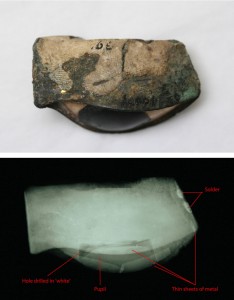 You can see in the right side of the x-ray image above that the two ends of the copper alloy frame are held together with a solder, or two drops of metal, on the inside edge of the frame. This was something that was not apparent from the outside.
You can see in the right side of the x-ray image above that the two ends of the copper alloy frame are held together with a solder, or two drops of metal, on the inside edge of the frame. This was something that was not apparent from the outside.
There are also two thin sheets of metal in between the frame and the top and bottom of the eye as well as a possible third small piece of thin metal on the outer corner of the frame. This metal is again not visible on the outside of the frame and it’s possible this was inserted to try to fill a gap between the eye and the frame to make the white fit more securely.
From the x-ray you can also see the shape of the basalt pupil and the hole in the white that was made to receive it. The hole is relatively uniform, with straight sides and flat base which could indicate that the hole was drilled. The basalt pupil, on the other hand, is uneven in profile and does not fill out the hole made for it.”
The original article can be found here https://fitzconservationstudents.wordpress.com/2013/04/15/examination-of-an-ancient-egyptian-inlaid-eye/
It seems remarkable how a microscope revealed the hole that had either been drilled or carved into the white of the eye for the pupil to be fitted and how a copper alloy had been used. Most intriguing, I think, is how solder had been used to hold the copper sheets together.